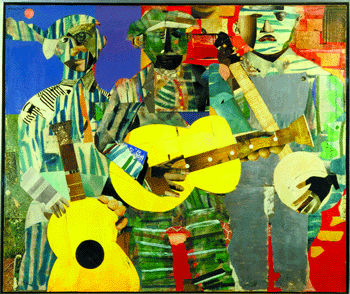Taking time for a late-year visit to the Whitney’s eclectic and vibrant offerings
The entire constellation of exhibitions at the Whitney Museum of American Art represent an instance when the parts equal the impressive sum of shows.
The palpable energy emanates from the small ground floor gallery, site of Jennifer Pastor’s amazingly clever three-part “Perfect Ride,” an installation which intelligently bundles concept and form, particularly in her large, opaque plastic and metal interpretation of the circulation system of the Hoover Dam. This and another sculpture of the inner ear are back-dropped by a poignant animation projected on the wall of the imaginary rhythm of what would be the “perfect” bull ride, a feat we are instructed would be impossible here are on earth, which is yet another reason to be grateful for art.
In exhibitions of the work of Isamu Noguchi, James Lee Byars and Bill Viola, the Whitney has mounted a noteworthy trifecta of very different American artists, each of whom was deeply influenced by Eastern contacts, particularly the culture of Japan.
Laid out beautifully, the large Noguchi exhibition is more informative than transcendent. Not surprisingly, the extent to which Noguchi’s sculpture expressed the leading forms of the 20th century, bridging the European work of Joan Miró, Pablo Picasso, Constantin Brancusi and Jean Arp, for example, with the American innovations of Alfred Steiglitz, Georgia O’Keefe and Arthur Dove—is indelibly on display. That Noguchi undertook such a challenging synthesis, while including Japanese influences, honoring his biracial identity, is remarkable.
Western artistic innovations of the last 100 years have often reflected innate Buddhist influences. The work of Bill Viola and James Lee Byars, who spent formative years in Japan exploring Zen philosophy, are significant examples.
If such a thing as Zen Baroque contemporary art existed, these artists would be its undisputed leading figures. Both weave radical Eastern philosophies of impermanence and empiricism into decidedly Western aesthetic frameworks and narratives.
Viola’s cinematic “Five Angels for a New Millennium” is a wonderfully seductive and gorgeously constructed meditation on the eternal examination of mortality and reincarnation. One of the most plangent qualities of this five-channel video installation is its breathtaking sound. Closing your eyes emphasizes its auditory independence, which is not to say that the visual component is anything short of awesome. If I have any complaint about Viola’s work, it is that it can veer toward being over the top and self-important. Nonetheless, his relevance is not in question here. Indeed, Viola helped frame the conversation about what is usually referred to as “video art,” and his work, like the angels in this piece, often sends waves rolling across the surface of his art.
Byars’ work shares some of the same exaggerated drama, particularly in his longstanding interest in the seductive material qualities of glass, white marble and gold, quite apparent in this exhibit, which is why his early ink drawings are particularly refreshing. One of Zen’s paradoxical tenets is that in nothingness everything is contained, accounting for an aesthetic approach that pares down materials to their bare, illuminating essentials. It is nice to see how easefully the simplicity springs from the ink drawings that were inspired by encounters with their classical Japanese counterparts.
Later on, particularly in the funereal “Death of James Lee Byars,” the lessons of these early drawings—where the simple materials retain a richness because of the restraint taken in their application—seem to have been dropped. Here Byars seems to extract and manipulate material qualities for a very bizarre rendition of his own 1997 death, which occurred not long after the original installation of this piece.
The small exhibition of video work on the second floor is off-beat, fun and worth spending some time with, if only to get a reprieve from the heavier elements of the above two exhibitions.
Finally, I love the Romare Bearden exhibition for the same reasons I love Alvin Ailey’s dance and taking the M60 bus to LaGuardia Airport—all are reminders of why I came to New York in the first place. In fact, the Bearden reminds me of the city itself, at least a part of Manhattan that seems to be disappearing. I don’t mean Harlem, but a certain rambunctious spirit, a defiant independence, which Harlem seems to be one of the last neighborhoods to represent. The exhibition is one of those rare opportunities—and the art world needs a lot more of them—where you can go and see yourself and your life. It’s always nice when the museum walls disappear and life comes whooshing in from the outside.



































